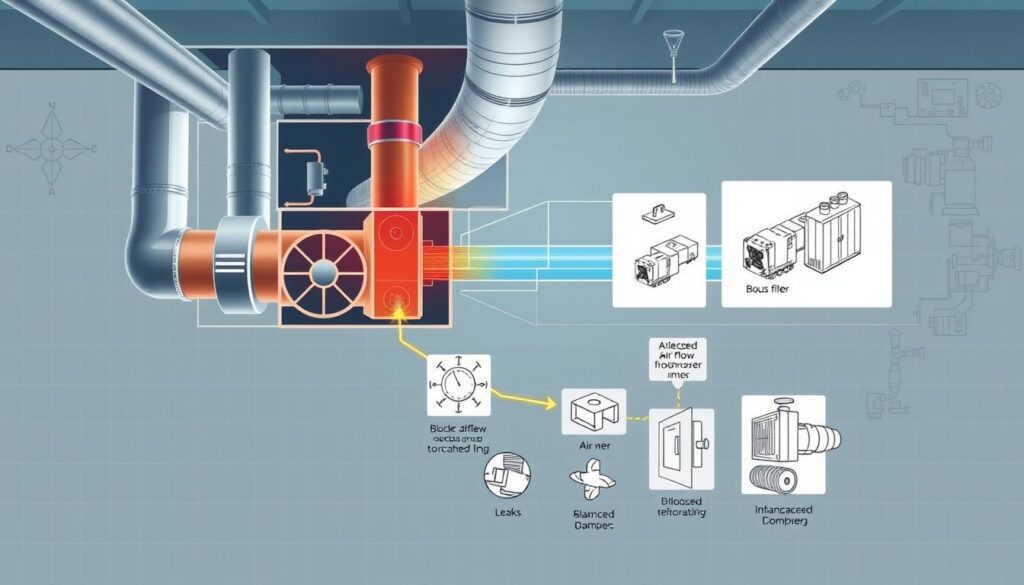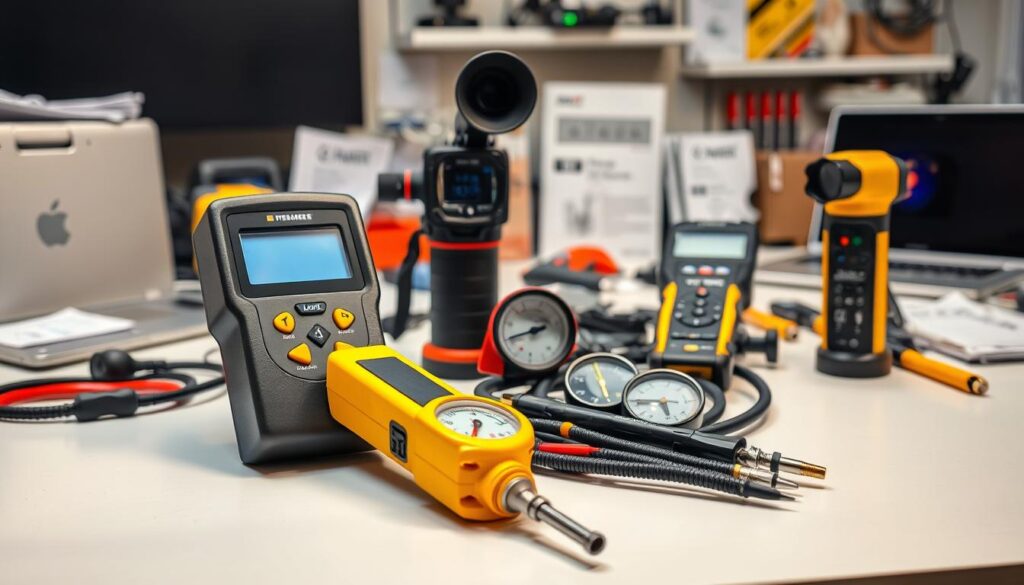Affiliate Disclosure
HVAC Guide Guys is a participant in the Amazon Services LLC Associates Program, an affiliate advertising program designed to provide a means for sites to earn advertising fees by advertising and linking to Amazon.
What Is A CFM In HVAC? Cubic Feet per Minute (CFM) shows how well your HVAC system moves air. Knowing about HVAC air volume is essential. It helps create a balanced, comfortable home environment.

Ever wondered why some rooms feel stuffy while others are perfectly comfortable? The answer lies in understanding CFM in HVAC. It affects your home’s air quality and comfort.
Learning about CFM opens up new insights into your HVAC systems. It helps you make better choices about comfort, energy use, and air quality.
Key Takeaways
- CFM measures the volume of air circulated in cubic feet per minute
- Proper CFM ensures optimal HVAC system performance
- Air volume impacts room comfort and temperature distribution
- CFM helps determine correct system sizing and capacity
- Understanding CFM can improve energy efficiency
Table of Contents
Understanding CFM Basics in HVAC Systems
Your HVAC system is a complex network of components working together to maintain comfortable indoor temperatures. At the heart of this system lies CFM, or cubic feet per minute. This is a critical measurement that determines how effectively air moves through your home.
CFM calculation for HVAC systems is essential for understanding how your air conditioning performs. Think of CFM as the breathing capacity of your HVAC system. It measures the volume of air circulated each minute.
Definition and Core Concepts
CFM represents the amount of air moving through your heating and cooling system. Here are key points to understand:
- One CFM equals one cubic foot of air passing a fixed point in one minute
- Proper CFM ensures consistent temperature and air quality
- Different spaces require different CFM measurements
How CFM Affects Your HVAC System
When learning how to measure CFM in air conditioning, consider these factors:
| CFM Impact | System Performance |
|---|---|
| Low CFM | Reduced cooling efficiency |
| High CFM | Potential system strain |
| Balanced CFM | Optimal comfort and energy use |
The Role of CFM in Air Distribution
Proper air distribution means every room receives adequate airflow. Accurate CFM calculations prevent hot or cold spots. This ensures your entire home maintains a consistent, comfortable temperature.
Precision in airflow management is the key to HVAC system efficiency.
What Is A CFM In HVAC
CFM is a key measure in hvac airflow. It stands for cubic feet per minute. It shows how much air your HVAC system moves in 60 seconds.
Knowing about CFM helps you see how well your system works. It’s like your home’s lungs. Your HVAC system moves air to keep your home comfy and the air clean.
“CFM is the heartbeat of your ventilation system, determining how effectively air circulates in your living space.”
- Measures air volume passing through a specific point
- Indicates system performance and efficiency
- Helps determine proper room ventilation
Different rooms need different CFM levels. Big rooms need more air, while small ones need less. Experts figure out the best CFM for your space to keep you comfy and save energy.
Getting your HVAC airflow right means your system works best. This saves energy and keeps your home at a steady temperature.
Explore Our HVAC Shop
Looking for top-rated HVAC tools, parts, and accessories? Visit our shop and find the perfect solution for your needs.
Visit the ShopThe Importance of Proper Airflow Measurement
Understanding airflow’s role in your HVAC system can change your home’s comfort and energy use. Good air circulation in HVAC means more than just air movement. It creates a perfect living space that keeps you cozy and saves on energy.
Getting the right CFM for cooling is key to your home’s climate. When your HVAC system moves the right amount of air, you get many benefits:
- Improved indoor air quality
- Even temperatures everywhere
- Less strain on your HVAC
- Lower energy bills
Benefits of Correct CFM Calculations
Accurate airflow measurement makes your HVAC system work its best. By matching the right CFM to your space, you avoid issues like hot spots and uneven cooling. This also saves energy.
Impact on System Performance
Your HVAC system’s life depends on balanced airflow. Wrong CFM can lead to early wear, higher maintenance costs, and lower efficiency. A pro can spot and fix airflow problems early, saving you money.
Energy Efficiency Considerations
Optimizing airflow also cuts your energy bills. A well-set HVAC system can save up to 20% on energy. This means big savings over time while keeping your home comfy.
CFM Requirements for Different Room Types
Knowing how much cfm per square foot is needed is key for the right HVAC size. Each room has its own airflow needs. These depend on the room’s function, how many people use it, and any environmental issues.
When it comes to homes, picking the right air flow is important. Here are some CFM tips for common rooms:
- Living Rooms: Usually need 1-2 CFM per square foot
- Bedrooms: About 1 CFM per square foot is needed
- Kitchens: They need more air, around 2-3 CFM per square foot
- Bathrooms: Special exhaust fans are needed to control moisture
Business spaces have their own air flow needs. Offices need more complex calculations for HVAC sizing. This is because of how many people are there and the heat from equipment.
Good ventilation is not just about feeling comfortable. It’s also about keeping the air healthy and efficient inside.
Places with a lot of moisture or pollutants need extra care. Kitchens and bathrooms need exhaust fans to keep the air clean and stop mold.
- Whole-house ventilation systems help manage air flow
- Think about your local climate and building insulation when figuring out CFM needs
- Getting a professional HVAC check can give you exact airflow advice
These tips are just a starting point. Your space might need a special HVAC size based on its own design and environment.
Calculating CFM for Your HVAC System
Learning to calculate cubic feet per minute (CFM) is key for your HVAC system’s best performance. The CFM calculation for HVAC systems shows the exact airflow needed for comfort and efficiency indoors.
Measuring HVAC airflow involves several important factors. Homeowners and professionals need to consider these to ensure their system works well. This means comfort and energy savings.
Basic CFM Formula
The formula for CFM is simple:
- CFM = Room Area (sq. ft.) × Ceiling Height (ft.) × Air Changes per Hour (ACH) ÷ 60 minutes
Room Size Considerations
Different rooms need different airflow amounts. Here’s a quick guide for room-specific CFM needs:
| Room Type | Typical CFM Range | Considerations |
|---|---|---|
| Bedroom | 50-80 CFM | Smaller spaces require less airflow |
| Living Room | 100-150 CFM | Larger areas need more circulation |
| Kitchen | 150-200 CFM | Higher airflow for heat and odor removal |
Adjusting for Climate Zones
Your local climate affects CFM needs. Hotter regions demand higher airflow for cooling. Colder areas might need less ventilation.
- Southern states: Increase CFM by 20-30%
- Northern states: Maintain standard CFM calculations
- Humid regions: Consider additional dehumidification needs
By accurately calculating and adjusting your HVAC system’s CFM, you can get the best comfort, energy efficiency, and air quality indoors.
Explore Our HVAC Shop
Looking for top-rated HVAC tools, parts, and accessories? Visit our shop and find the perfect solution for your needs.
Visit the ShopCommon Airflow Problems and Solutions

Your HVAC system works best with good air flow. Finding and fixing airflow problems can make your home more comfortable and save energy.
There are a few signs that show your HVAC system might have airflow issues:
- Inconsistent room temperatures
- Weak air streams from vents
- Uneven air pressure throughout your home
- Warm air blowing when AC should be cooling
Knowing how to size your HVAC system by cfm helps spot airflow problems. The main reasons for poor airflow are:
- Clogged air filters blocking air flow
- Leaking or damaged air ducts
- Malfunctioning fan mechanisms
- Blocked or closed vents
To fix these problems, start with some basic steps:
- Replace air filters regularly
- Check ductwork for leaks
- Make sure vents are open
- Get a professional to check your HVAC system
“Proper air circulation in HVAC systems is not just about comfort, but also about maintaining system efficiency and longevity.” – HVAC Professional
Professional technicians can do detailed checks to find airflow problems. They can then suggest the best fixes for your home’s HVAC system.
CFM and Air Changes Per Hour (ACH)
Understanding HVAC air volume is more than just numbers. Air Changes Per Hour (ACH) is key to knowing if your home’s air is clean and fresh. It’s important for keeping your cooling system working well.
ASHRAE standards are like a guidebook for keeping your home air perfect. They help both homeowners and HVAC experts make sure your air moves right and is clean.
ASHRAE Standards for Ventilation
The American Society of Heating, Refrigerating, and Air-Conditioning Engineers (ASHRAE) sets important rules for cooling your home. They focus on two main things:
- Minimum ventilation rates
- Indoor air quality standards
- Occupant health and comfort
Recommended ACH Rates
How much air change you need depends on the room and how many people are in it. Each space needs its own air plan to stay healthy.
| Space Type | Recommended ACH | Ventilation Purpose |
|---|---|---|
| Bedrooms | 0.35 – 1.5 | Sleep quality |
| Living Rooms | 1.0 – 2.0 | Comfort and air circulation |
| Kitchens | 2.0 – 3.0 | Odor and moisture control |
“Effective ventilation is not just about moving air, but about creating a healthy indoor environment.” – HVAC Engineering Professional
Your HVAC system’s air management affects your comfort, energy use, and air quality. Knowing these details helps you choose the best ventilation for your home.
Explore Our HVAC Shop
Looking for top-rated HVAC tools, parts, and accessories? Visit our shop and find the perfect solution for your needs.
Visit the ShopProfessional CFM Measurement Techniques

Measuring cfm in air conditioning needs special skills and top-notch tools. HVAC airflow measurement is more than a DIY task. It’s a precise science.
Professional technicians use advanced methods to measure airflow in HVAC systems:
- Flow Hood Measurement: A special device placed over vents to measure air volume directly
- Duct Traverse Method: Uses probes in ductwork for precise measurements
- Anemometer Testing: Wind speed instruments help calculate air movement
The best hvac airflow measurement techniques involve complex calculations. They consider many factors:
- Duct size
- Air speed
- Temperature changes
- System setup
Professional HVAC experts have the skills and tools to spot issues others might miss. They use precise instruments to make sure your system works at its best. This can save you a lot on energy costs.
Accurate CFM measurement is not just about numbers—it’s about creating optimal comfort and system performance.
For the best results, hire certified HVAC pros. They offer detailed airflow analysis and advice suited to your system and space needs.
Converting CFM to Tons in HVAC Systems
Knowing how to change CFM to tons is key for sizing HVAC systems correctly. A simple rule of thumb helps professionals and homeowners figure out cooling capacity.
To convert CFM to tons, remember this: 1 ton of cooling equals 400 CFM of airflow. This makes it easy to find the right system size for your space.
- 2-ton AC unit requires approximately 800 CFM
- 3-ton AC unit needs around 1,200 CFM
- 5-ton AC unit demands about 2,000 CFM
But remember, this rule isn’t set in stone. Other things can change how much CFM you need, like:
- Climate conditions
- Building insulation
- Ceiling height
- Number of windows
Experts use this rule as a starting point. They do detailed work to make sure the system fits your cooling needs perfectly.
Getting CFM to tons right is vital for your HVAC system’s performance and saving energy.
Explore Our HVAC Shop
Looking for top-rated HVAC tools, parts, and accessories? Visit our shop and find the perfect solution for your needs.
Visit the ShopTips for Maintaining Proper CFM Levels
Keeping your HVAC system’s air flow right is key. It affects your comfort, energy use, and system life. With the right maintenance, you can meet your home’s cooling needs.
Regular Maintenance Requirements
Regular upkeep is vital for your HVAC’s air flow. Make a detailed maintenance plan that includes:
- Quarterly professional checks
- Annual full system reviews
- Cleaning all parts inside and out
- Checking the refrigerant
Filter Management Strategies
Clean filters are a must for good air flow. Dirty filters block air and lower efficiency. Here’s how to keep them clean:
- Change filters every 90 days
- Use top-notch MERV-rated filters
- Inspect filters monthly in dusty areas
- Think about washable filters for savings
Ductwork Considerations
Your ducts are key for cooling air flow. Keep them in good shape to avoid air blockages:
- Seal air leaks
- Clean ducts every 3-5 years
- Make sure they’re well-insulated
- Look for blockages or damage
Pro Tip: Get a pro to check your air flow. They can spot issues and suggest fixes.
Conclusion
Knowing what a CFM in HVAC means is key to a comfy and efficient home. Your HVAC system’s performance relies on managing air volume well. This affects your comfort and how much energy you use.
In this guide, we covered the basics of HVAC air volume and its big role in system improvement. Learning about CFM calculations and airflow needs helps you make smart choices for your home’s heating and cooling.
At Trane, we know how important accurate airflow measurement is. When you’re thinking about HVAC upgrades or maintenance, talk to professional technicians. They can help you get your system’s CFM levels just right. This can improve your air quality, keep temperatures steady, and cut down on energy costs.
Your HVAC system’s efficiency depends on how well it moves air. By focusing on CFM and keeping your equipment in good shape, you’ll have a cozy, energy-saving home for many years.

